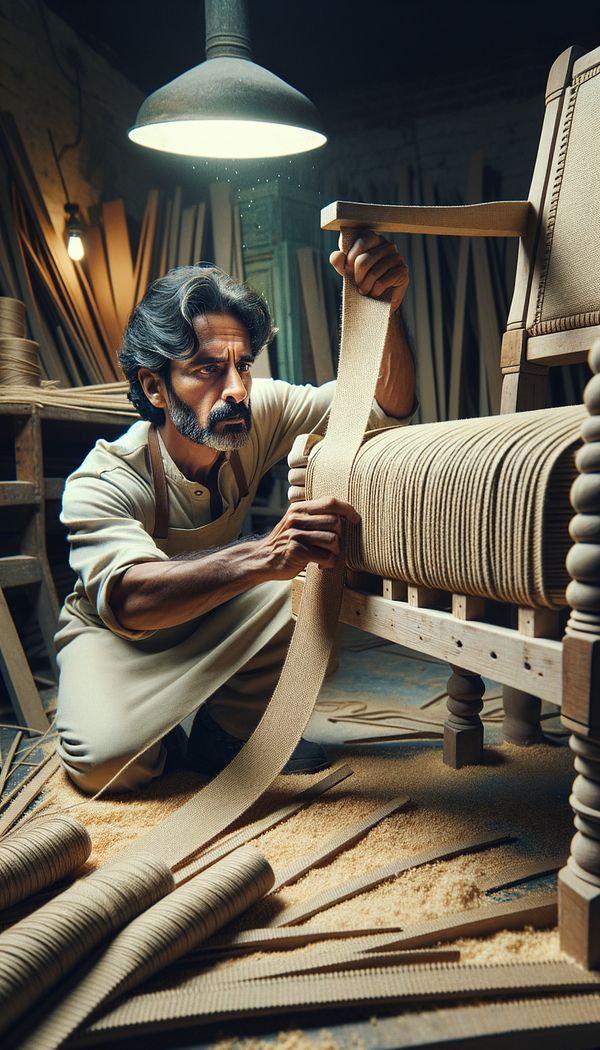What is Webbing?
Webbing is a strong, flexible strip of fabric used in furniture construction.
Description
In the realm of interior design, webbing is a key element with a fundamental purpose that often goes unnoticed. This sturdy, woven band of fabric provides essential support for furniture constructions, specifically within seating like chairs and sofas. The versatility of webbing's material – often made from jute, nylon, or rubber – ensures it can offer both durability and a certain degree of elasticity. This combination is crucial for creating furniture that is not only stable but also comfortable to use over time.
Webbing is utilized in two primary ways: as support for seat bases and backs. In chairs and sofas, it is tightly stretched across the frame to provide a firm foundation upon which cushions and other padding can rest. This allows for an even distribution of weight and contributes significantly to the furniture's overall comfort and longevity. It's especially important in items that lack the traditional spring systems, offering an alternative that can be equally, if not more effective, depending on the design requirements.
Aside from its functional benefits, webbing can also contribute to a piece of furniture's sustainable credentials. Materials like natural jute offer environmentally friendly options, appealing to those concerned with sustainability in interior design. This aspect ties into an increasingly relevant conversation around eco friendly design and material choices within the industry.
Usage
In practice, webbing is commonly seen in high-quality furniture design. An interior designer might opt for jute webbing in a bespoke armchair to ensure exceptional durability and comfort, reflecting a commitment to quality and environmental considerations. Similarly, a restorative furniture project could utilize nylon webbing to replace old, worn-out components, thus extending the piece's life and reducing waste.
FAQs
-
Why is webbing used in furniture?
Webbing is used in furniture to provide a stable and comfortable support system for cushions and seating areas, enhancing durability and comfort.
-
What materials is webbing made from?
Webbing is typically made from materials such as jute, nylon, or rubber, each offering different levels of strength and flexibility.
-
Can webbing be considered eco-friendly?
Yes, when made from natural materials like jute, webbing can be considered an eco-friendly option within interior design projects, aligning with sustainable design principles.
-
How does webbing compare to springs in furniture?
Webbing and springs serve similar purposes but in different ways. Webbing offers a more flexible support system, which can be preferable in certain design contexts, while springs provide a traditional, bouncy feel.
Practical Application
When choosing webbing for a furniture project, consider the material that best suits the item's intended use and aesthetic. For instance, jute webbing might be the perfect choice for a piece aiming for a natural, rustic look, while nylon could be better for modern, high-traffic areas. Always ensure the webbing is securely attached and stretched appropriately to maintain the furniture's integrity and comfort over time.
-
Furniture Types599 articles
-
Fabrication & Craftsmanship133 articles
-
Materials & Textiles360 articles
-
Sustainability & Eco-Friendly Design69 articles
-
Jewelry ArmoireA jewelry armoire is a freestanding cabinet designed specifically for storing and organizing jewelry and accessories.
-
Trestle TableA trestle table is a table consisting of a flat top supported by two or three trestle supports.
-
Book MatchBook Match refers to a mirror-like reflection technique used in the placing of two matching surfaces.
-
SilhouetteThe outline or general shape of an object.
-
CoverletA coverlet is a lightweight, decorative bedspread.
